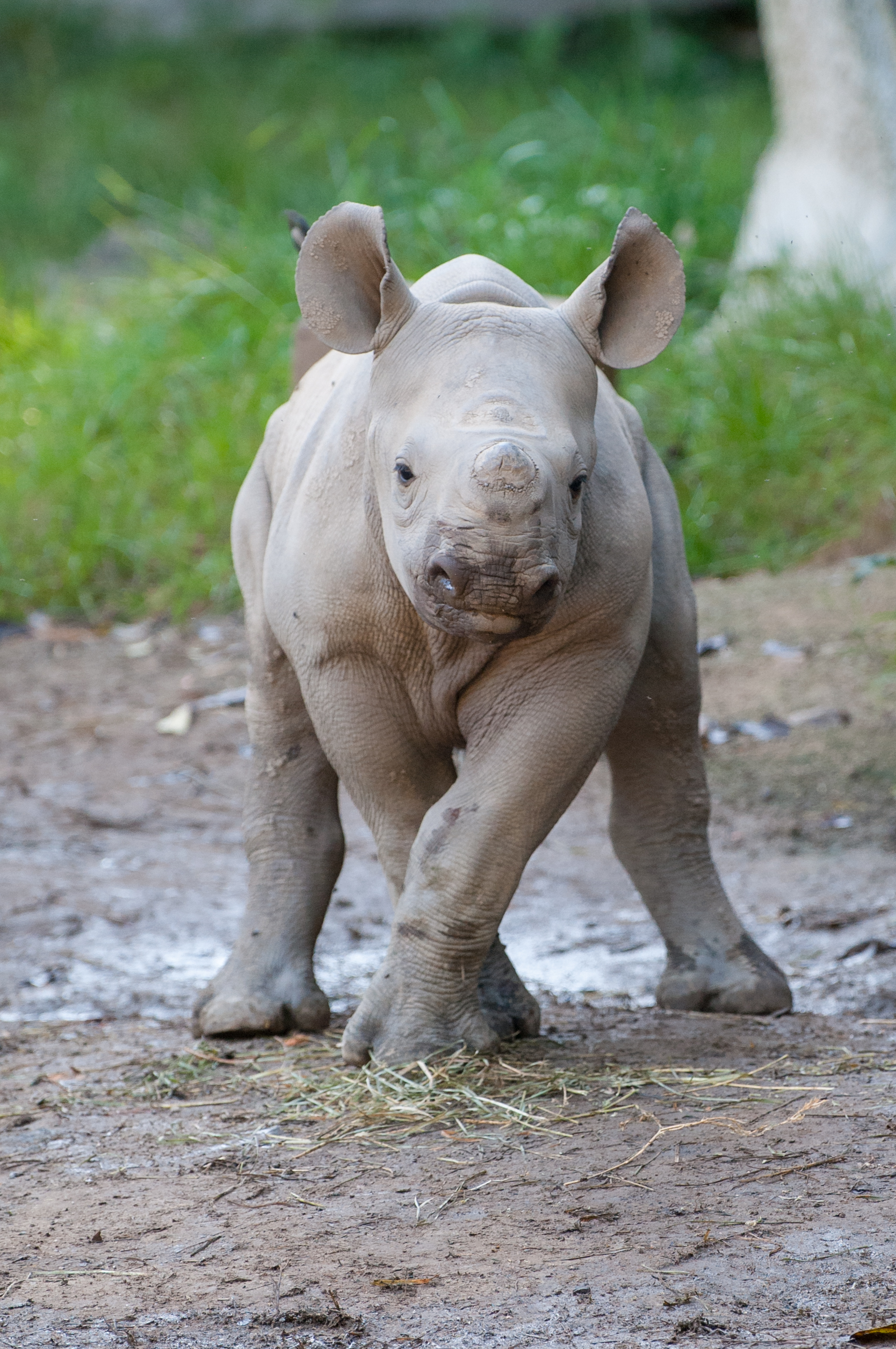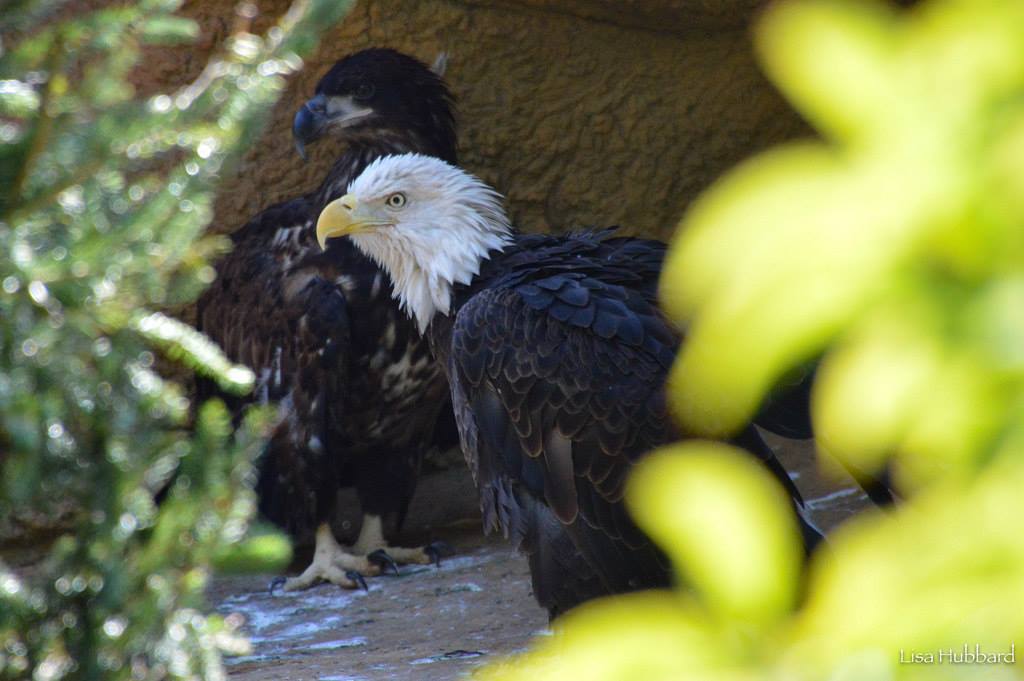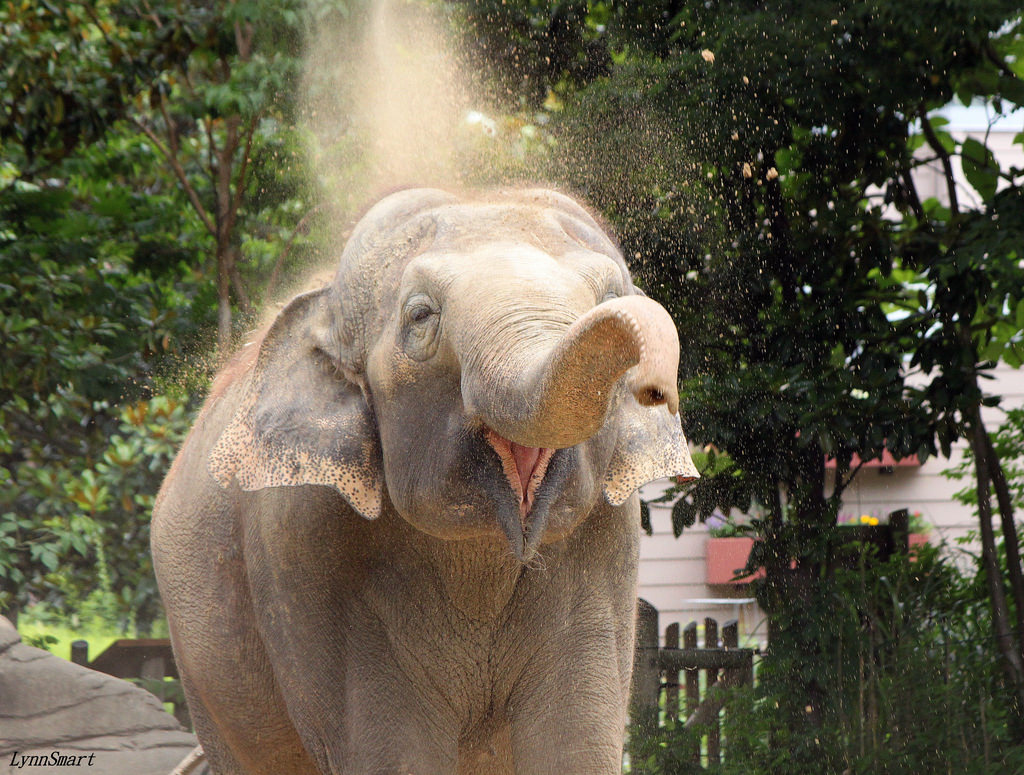My Zoo Did This!
The Cincinnati Zoo is a leader in conservation efforts around the world. By supporting accredited zoos like ours, you’re also part of the solution!
Check out what the Zoo has been up to so far in 2018:
Fiona the Ambassador Hippo
On January 24, 2018, Fiona, the premature baby hippo, celebrated her first birthday! Fiona’s birthday is a major milestone. She was born six weeks premature and weighed only 29 pounds, about half as much as the low end of the normal birth weight for a Nile hippo. Thanks to the Cincinnati Zoo’s animal care team, and a helping hand from Cincinnati Children’s, Fiona survived.
Fiona has raised awareness and interest in hippos. She’s an ambassador for her species and a great example of why zoos exist. She survived because of the animal care team’s tireless efforts to save her and has inspired so many to care about her species and wildlife, which is Cincinnati Zoo’s mission.
Interest in the Nile hippo and protecting its habitat in Africa benefits all species, many critically endangered, that share their ecosystem. “Hippos are ‘ecosystem engineers’, meaning they shape the environment around them. They create grazing areas that act as connection between land and water habitats and bring nutrients and microorganisms into the water from the land and vice versa as they travel between the two,” said Dr. Jessye Wotjusik, a scientist with Cincinnati Zoo’s Center for Conservation and Research of Endangered Wildlife (CREW) and person who saw the first image of Fiona (first ever ultrasound image of a Nile hippo).
“They’re also indicator species and can provide us with an idea of how changes in climate may be impacting their ecosystem and other animal populations. For example, if a population of hippos die off due to lack of water this is indicative that such drought conditions may not be normal for that region and also that many other species are likely suffering,” said Wojtusik.
While not considered endangered, wild populations are currently declining due to habitat loss and degradation, increased incidence of drought, and some poaching. Increased drought and less rainfall means there is less grazing areas for hippos to rely on for food. They will travel upwards of 35km in one night to find food, but the larger issue is that by having to search for food or water, there is a much greater chance of conflict with people/livestock, especially since the human population is increasing.
Critically Endangered Tigers and Rhino Also Turn One!
Chira, Batari, and Izzy are our 1.5 year old Malayan tiger sisters. They are wonderful ambassadors for their species. These cubs are critically endangered and the most genetically valuable females in the United States. We’re hoping that they will contribute to the survival of their species by producing offspring when they become sexually mature.
 Black rhinos like Kendi, his mom Seyia and dad Faru are critically endangered and need our love. “Every rhino calf born is incredibly important for the population, which includes fewer than 60 in North America. Calves will stay with their mothers for 3-4 years which means that the average female can only have one calf every 5 years,” said Christina Gorsuch, curator of mammals at the Cincinnati Zoo. “This calf is only the fifth eastern black rhino born in the last two years in North America. Only one surviving calf was born in 2014/2015.” The species is Critically Endangered due to poaching and habitat loss. Fewer than 5,000 black rhinos remain in the world
Black rhinos like Kendi, his mom Seyia and dad Faru are critically endangered and need our love. “Every rhino calf born is incredibly important for the population, which includes fewer than 60 in North America. Calves will stay with their mothers for 3-4 years which means that the average female can only have one calf every 5 years,” said Christina Gorsuch, curator of mammals at the Cincinnati Zoo. “This calf is only the fifth eastern black rhino born in the last two years in North America. Only one surviving calf was born in 2014/2015.” The species is Critically Endangered due to poaching and habitat loss. Fewer than 5,000 black rhinos remain in the world
Rehabilitating Rescued Manatees
Cincinnati Zoo participates in the Manatee Rescue and Rehabilitation Partnership (MRP), a program designed to rescue and treat sick, injured and orphaned manatees and then release them back into the wild. In April 2018, the Cincinnati Zoo took in a fourth manatee for rehabilitation. Daphne and her mother were rescued from Florida waters on Monday, April 9, after her mother was struck by a boat. The mother did not survive.
 Thus far, 2018 has been a tough year for manatees in the state of Florida. Between January 1st and August 18th the Florida Fish and Wildlife Conservation Commission (FWC) documented a total of 554 Manatee deaths, which surpasses the 538 deaths in 2017. At the current rate, 2018 will replace 2013 (when 830 deaths were documented) as the deadliest year for manatees in the state of Florida.
Thus far, 2018 has been a tough year for manatees in the state of Florida. Between January 1st and August 18th the Florida Fish and Wildlife Conservation Commission (FWC) documented a total of 554 Manatee deaths, which surpasses the 538 deaths in 2017. At the current rate, 2018 will replace 2013 (when 830 deaths were documented) as the deadliest year for manatees in the state of Florida.
Since 1999 the Cincinnati Zoo & Botanical Garden has participated in the United States Fish and Wildlife Service’s Manatee Rescue & Rehabilitation Partnership (MRP). The Cincinnati Zoo has cared for 19 Florida Manatees, 14 of which have been released.
Polar Bears
 We are proud to partner with Polar Bears International as an Arctic Ambassador Center to help save polar bears & their habitat by reducing carbon emissions! Each year we celebrate polar bear day – and this year we had exciting polar bear breeding sightings! After a chilly start, things are finally heating up for Anana and Little One. It has been more than 25 years since the Zoo has had polar bear cubs. There’s no pregnancy test for polar bears, so we have to proceed as if cubs are on the way.
We are proud to partner with Polar Bears International as an Arctic Ambassador Center to help save polar bears & their habitat by reducing carbon emissions! Each year we celebrate polar bear day – and this year we had exciting polar bear breeding sightings! After a chilly start, things are finally heating up for Anana and Little One. It has been more than 25 years since the Zoo has had polar bear cubs. There’s no pregnancy test for polar bears, so we have to proceed as if cubs are on the way.
As science and research gives us a better understanding on how to care for and help breed polar bears, the Zoo has plans to expand and make modifications to its current Kroger Lords of the Arctic habitat as part of the More Home to Roam campaign. This includes creating an environment conducive to breeding and rearing cubs, providing isolated denning opportunities for female polar bears, separate habitat areas for male and female bears and natural substrates.
We’re also keeping activity and noise in the area to a minimum over the next few months. You can help polar bears too! Using less energy produced by carbon-based fuels reduces our carbon emissions, in turn, saving our sea ice. Polar bears require sea ice for efficient hunting. Without sea ice, polar bears will decline in range and numbers, making them vulnerable to extinction in the future.
Giraffe
Did you know the giraffe was recently listed as Vulnerable on the IUCN Red List of Threatened Species with a 40% decrease in their population over the last 30 years? The Cincinnati Zoo is working to help save these gentle giants.
Giraffe populations are suffering from habitat loss, trophy hunting, illegal poaching, and war-stricken habitat. Here at CZBG, we support wild Maasai giraffe conservation by offering “behind the scenes” tours with proceeds going to the Wild Nature Institute.
You can help by recycling used/non-functioning plastic swipe cards at your local Best Buy. Examples include:
- Used gift card
- Old hotel room key
- Expired rewards card
- Any plastic card
- Old key chain cards (gym, grocery, gas station)
Eagle
 We now have two bald eagles in our new, spectacularly-landscaped bald eagle habitat. Adult female Klaus joined juvenile Griffin earlier this week and the two have been settling in nicely! Both were rescued and are unable to fly. Klaus was found in a backyard in Orlando, FL, on Christmas Eve suffering from a wing injury. She was rehabbed at the Avian Reconditioning Center in Florida, but they couldn’t provide her with a permanent home. According to her care team, she loves baths and fish.
We now have two bald eagles in our new, spectacularly-landscaped bald eagle habitat. Adult female Klaus joined juvenile Griffin earlier this week and the two have been settling in nicely! Both were rescued and are unable to fly. Klaus was found in a backyard in Orlando, FL, on Christmas Eve suffering from a wing injury. She was rehabbed at the Avian Reconditioning Center in Florida, but they couldn’t provide her with a permanent home. According to her care team, she loves baths and fish.
Notable Births
Winsol the Aardorable Aardvark
Ali, the Cincinnati Zoo & Botanical Garden’s 13-year-old female aardvark, gave birth to a baby boy on December 21, 2017. Winsol (born on the Winter Solstice) is the first healthy aardvark baby to be born at the Zoo since 1994.
And the Cincinnati Zoo is milking it! Whenever possible, the Zoo’s animal care team gets milk from lactating moms so scientists can analyze the composition. In Fiona the hippo’s case, knowing what was in her mom’s milk saved her life. Now, Ali the aardvark is making weekly deposits to the Smithsonian’s National Zoo’s Exotic Animal Milk Repository so scientists can create a recipe for synthetic aardvark milk!
Ocelot
In collaboration with the animal care staff at the Arizona-Sonora Desert Museum, scientists from the Cincinnati Zoo’s Center for Conservation and Research of Endangered Wildlife (CREW) have produced their second pregnancy in ocelots using a novel fixed-time artificial insemination (AI) method. The birth of a healthy female kitten, after an 82 day gestation, provides further proof that this fixed time AI approach can serve as a valuable adjunct to natural breeding for ocelot conservation efforts in zoos. Read more here!
Saki
It’s a girl! Keepers confirmed the white-faced saki baby is female and named her “Selva”, Spanish for rainforest. While Selva is doing great here at the zoo, it was recently reported that the equivalent of 40 football fields of rainforests are cut down around the world every minute. Not good news for wild sakis or the thousands of other species that depend on rainforests around the globe including humans. Rainforests are the lungs of the planet and create a large amount of Earth’s oxygen. They also serve as water reservoirs that disperse rainfall evenly across countries including the US. Escalating deforestation is contributing to significant drought conditions worldwide.
You can help wild sakis and rainforests by choosing certified sustainably grown lumber for your projects. And you can see little Selva in the zoo’s rainforest interpretive habitat, Jungle Trails.
Guam Rail Chicks
Guam rails are extinct in their natural habitat, but there is still hope for the species. Two chicks that hatched in August at the Cincinnati Zoo may play a part in bringing the wild population back!
In the Field
In addition to the multiple field projects the Zoo is involved with, here are some newsworthy stories from 2018.
Congo
In 2018, the Cincinnati Zoo journeyed back to the Congo! The Cincinnati Zoo has financially supported research and conservation efforts here for the last two decades. Read more and see photos from the trip from Cincinnati.com.
Tortoises in Madagascar
In May, two keepers from the Cincinnati Zoo, Melanie Evans and Paul Reinhart, arrived in a remote part of the remote island of Madagascar last week to help save the more than 10,000 critically endangered radiated tortoises that Turtle Survival Alliance (TSA) rescued from poachers last month. Several AZA-accredited Zoos and Aquariums have dispatched animal care staff to administer medical care for thousands of tortoises that were found sick or injured and general care for the ones that were in better shape.
Follow their trip here.
Two experts from the Cincinnati Zoo, Melanie Evans & Paul Reinhart, traveled to the remote island of Madagascar last week to help save the more than 10,000 critically endangered radiated tortoises that Turtle Survival Alliance rescued from poachers last month. This is a critical conservation mission. It is estimated that radiated tortoise populations in the wild have declined more than 80 percent in the last 30 years. At this rate of decline, the species could be functionally extinct in less than two decades. Thanks to our dedicated keepers & the other staff & volunteers who helped with this rescue mission! #cincinnati #cincinnatizoo #savingspecies #closeenoughtocare
A post shared by Cincinnati Zoo (@cincinnatizoo) on
World of the Insect
Happy 40th Anniversary to our World of the Insect! In 1978, the first exhibit building devoted to insects in any U.S. zoo was built at the Cincinnati Zoo and was awarded the American Zoo and Aquarium Association’s (AZA) Exhibit Award.
Many significant achievements in husbandry, breeding and display of particular species, including the bullet ant, Peruvian fire stick and giant water bug, have received special awards over the years.
 Build a Better Home for Wildlife
Build a Better Home for Wildlife
The Zoo has also stepped up its efforts to build a better home for wildlife right here in our local community over the past year, from releasing critically endangered American burying beetles to restoring natural wildlife habitat on our EcOhio Farm. You can join us in these efforts by participating in the Family Community Service program, which offers opportunities for adults, families and small groups to engage in local, hands-on conservation projects in the Greater Cincinnati region. You can also build a better home for wildlife by planting pollinator-friendly plants and putting up bird feeders and nest boxes for wildlife in your own backyard. Look here for tips on how to get started.
Community
Also known as the Greenest Zoo in America, we’re working to make our neighborhood of Avondale one of Cincinnati’s most energy efficient communities, thanks to a grant from the Duke Class Benefit Fund. Read more!
Follow the Cincinnati Zoo on Facebook, Instagram and Twitter to make sure you don’t miss any of our cute animals and even more important conservation stories!



